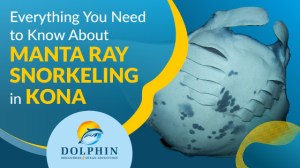EVERYTHING YOU NEED TO KNOW ABOUT MANTA RAY SNORKELING IN KONA

Have you been dreaming of experiencing manta ray snorkeling in Kona? You’ve probably heard about plenty of incredible things and adventures to try in Kona, but there is nothing else like manta ray snorkeling!
What’s so unique about manta ray snorkeling?
For starters, you’ll be swimming with one of the world’s most famous fish species, in the middle of the ocean, at night! But before you start your venture, there are some things you should know about this unique and fun opportunity. To help you, we’ve rounded up some of the essential information you should know about manta ray night snorkeling. Check it out below.
What is Manta Ray?
According to National Geographic, brilliant and highly threatened manta are the world’s most prominent rays. The sea creatures live in tropical, subtropical, and temperate ocean waters across the globe. They have two horn-shaped fins protruding from the front of their heads called cephalic fins.
Manta rays are gentle and graceful creatures in the same order as sharks. They don’t have bones, teeth, or barbs in their body. The reef manta rays in Hawaii do not migrate. Instead, Hawaii is their home all year round during their 50-year lifespan.
They are solitary creatures that only come together to feed and mate. However, on the Kona Coast on the Big Island of Hawaii, there are famous viewing sites where mantas come to feed at night, giving you at least a 90% sighting chance during your excursion.
Swimming with Manta Rays: Is It Safe?
Absolutely!
Manta rays are known to be peaceful creatures, making your diving experience not only magical but also unforgettable. They feed on plankton, filtering them out of the water with their giant mouths open. So whether you choose Manta Ray night snorkeling or diving, you don’t have to worry about your safety and just enjoy a magical night with them!
These large creatures look intimidating underwater but do not harm humans; they are only interested in plankton. Take note that manta rays are different from stingrays. Manta rays do not have a stinger or barb and are often called “gentle giants.”
What Makes Manta Ray Snorkeling in Kona Special?
During the manta ray snorkeling Kona activity, you will witness many manta rays, seemingly dancing, up close and personal. Your in-water guides will move you to the best manta ray viewing sites. You’ll be holding on to a large floating device that has specially designed lights that brings in the manta ray’s food, zooplankton. The mantas will often get up close and personal and swim within inches of your face. These animals can grow up to 18 feet wide and weigh over 2,000 lbs. There are plenty of manta ray snorkeling tours in Kona. The activity essentially starts with everyone onboard a boat which will take you to the snorkeling spot where manta rays love to hang out. En route to the area, your guide will explain the necessary details you need to know while doing the activity.
The Best Spots for Manta Ray Snorkeling
Manta Ray Village
Located directly in front of the Outrigger Kona Resort & Spa at Keauhou Bay, south of Kona, it’s considered the original and most popular manta ray snorkeling Kona location. Reportedly, it has an average sighting rate of 95% or an average of four manta rays per tour.
Manta Ray Heaven
Manta Ray Heaven is located at the western tip of the island, north of Kona, by Keahole Point. It is a popular spot for manta ray divers, but some operators conduct a few night snorkeling with Manta rays Kona tours here.
What to Bring on the Snorkeling Activity?
- Swimsuit and towel
- Dry bag
- Jacket or light outer layer
- GoPro and a floating attachment (for your documentation)
Things to Remember During Snorkeling with Manta Rays
Observe and do not touch.
Manta rays have a protective mucus coating that rubs off when you touch them. During your night snorkeling with manta rays, make sure not to grab the mantas. If you have kids, ensure they understand this before going underwater.
Stay in your designated position/area.
For snorkelers, stay on the surface and keep your legs in a horizontal position. Floatation devices for your legs are provided to keep you in position. Listen carefully and follow instructions.
Remember how to position your cameras.
Snorkelers will need to keep their cameras close to their bodies as the manta rays often come very close. Bug-eyed cameras seem to have the best results to capture the sheer size of the manta rays.
Create Beautiful Memories with Dolphin Discoveries
If you’re looking for a snorkeling experience with majestic manta rays under the blanket of the starry Hawaiian sky, Dolphin Discoveries is dedicated to helping you form beautiful memories!
Join us on this wonderful adventure by booking your trip with us. Get in touch with us today!
